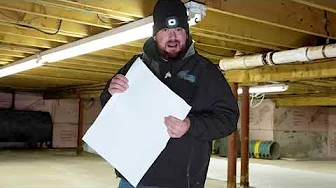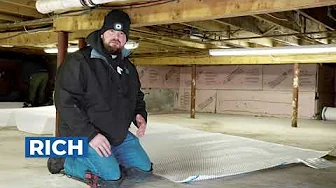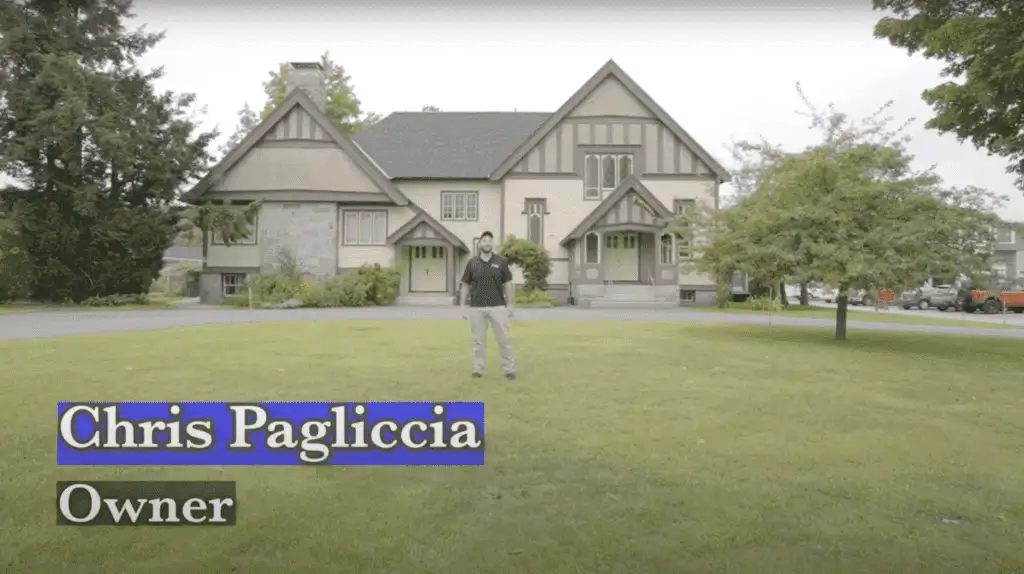Foundation Crack Repair Portsmouth NH
Cracks in your foundation are never a good sign. They can compromise the structural integrity of your home and lead to serious issues like water damage, mold growth, and uneven floors if left unchecked. In Portsmouth, NH, where seasons bring a mix of freezing winters and humid summers, foundations often endure a cycle of expansion and contraction, making cracks a common problem for homeowners.
Addressing foundation cracks promptly helps protect your home’s value and prevents more costly repairs down the line. Here’s what you need to know about foundation crack repair in Portsmouth, NH.
Real People - Real Great Results
Crawl Space Video Playlist
Causes of Foundation Cracks
Foundation cracks don’t just appear out of nowhere—they’re the result of forces at play beneath and around your home. In Portsmouth, NH, where the environment is a mix of coastal influence and New England’s unpredictable weather, understanding the main culprits can help you prevent future damage. Here’s a closer look at what typically causes foundation cracks:
- Soil Movement: Your foundation relies on the stability of the soil it rests on. But soil isn’t static—it can shift due to moisture changes from heavy rain, melting snow, or even extended dry spells. Portsmouth homeowners, in particular, face the added effects of coastal humidity and sandy, unstable soil in certain areas. These shifts can lead to settlement and, yes, cracks.
- Weather Extremes: New Hampshire winters can be brutal, and the freeze-thaw cycle doesn’t do your foundation any favors. Water in the soil freezes, expands, and puts pressure on your foundation. When it thaws, the soil contracts, loosening support. This repeated stress is like a tug-of-war on the concrete, eventually leading to cracks.
- Poor Drainage: Water always seeks the path of least resistance, and if your drainage system isn’t doing its job, it will pool around your foundation. Over time, this pressure can force cracks—and worse, water intrusion—into your basement or crawl space.
- Construction Issues: Sometimes the problem isn’t with the environment but how your home was built. If corners were cut with low-quality materials or sloppy work, it leaves your foundation vulnerable. Combine that with Portsmouth’s climate, and you’ve got a recipe for faster degradation and inevitable cracks.
- Tree Roots: Those towering trees in your yard may look majestic, but their roots could be wreaking havoc underground. In their search for water, roots can dry out soil unevenly or even push against your foundation directly. The result? Cracks that grow larger as the roots spread.
Understanding why foundation cracks happen is the first step in addressing and preventing them. It’s not just about patching the visible damage but tackling the root cause to ensure your home stays solid for years to come.
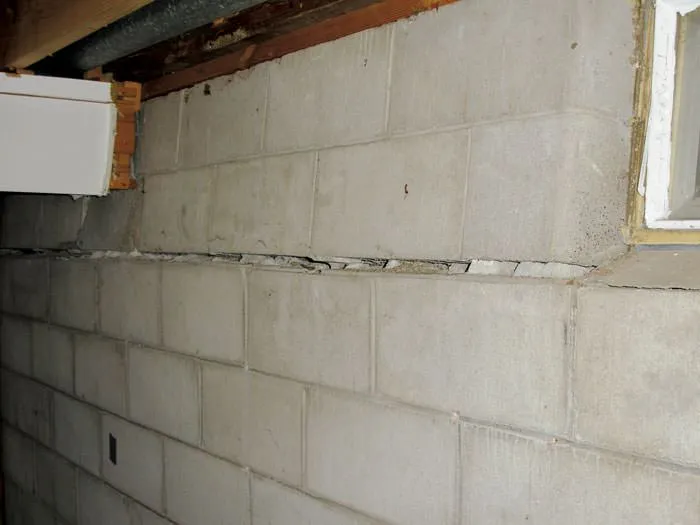
Types of Foundation Cracks
Not all foundation cracks are created equal. Their direction, size, and location reveal a lot about what’s happening below the surface of your home. Identifying the type of crack is the first step to understanding its severity and the appropriate solution. Here’s a quick breakdown:
- Horizontal Cracks: These are the heavyweight warning signs. Horizontal cracks often indicate serious structural stress from exterior pressure, such as water-saturated soil pushing against basement walls. If you spot one, don’t waste time trying to figure it out on your own—call a professional immediately. Left untreated, horizontal cracks can lead to bowed walls or even foundation collapse.
- Vertical Cracks: The most common and least ominous type, vertical cracks are usually caused by normal settling of the home. These tend to be narrow and don’t run the full height of the wall. That doesn’t mean you should shrug them off, though. Small vertical cracks can allow water to seep into your basement, which opens the door to water damage and mold. Quick sealing with epoxy or polyurethane injections usually does the trick here.
- Diagonal Cracks: A diagonal crack often points to uneven settlement or pressure on one side of the foundation. Maybe one corner of your house is sinking faster than the rest, or the soil isn’t evenly compacted. These cracks can vary in severity—narrow ones might just need sealing, but wider or growing diagonal cracks could demand a more involved repair, like underpinning.
- Hairline Cracks: The least intimidating at first glance, hairline cracks are incredibly thin but can still cause trouble over time. Ignore them, and they could widen as water, temperature changes, or soil shifts play their part. Fix them early with a simple sealant to keep them from becoming a bigger, more expensive headache.
Understanding the type of foundation crack you’re dealing with cuts through the guesswork. Whether it’s a harmless cosmetic issue or a sign of deeper structural trouble, knowing what you’re up against helps you make the right call on repairs. In foundation work, ignoring the small stuff is never a good policy. Play it safe and act quick.
Warning Signs of Foundation Issues
Before cracks even make their grim debut, your home often whispers its warnings. Pay attention. Uneven floors might trip you up—literally and figuratively. If you notice doors or windows sticking like they’re staging a quiet rebellion, it’s time to ask why. Gaps between walls and ceilings—or walls and floors—are another red flag. These aren’t “character quirks;” they’re signals that your foundation may be shifting.
Basement or crawl space damp? That’s not just a musty nuisance. Water infiltration often finds its way in through cracks invisible to the naked eye—cracks that will only grow if ignored. If your foundation walls are bowing or bulging, then the problem has skipped past subtlety and gone straight into structural alarm bells. Don’t wait for catastrophe; the signs are already there.
DIY vs. Professional Repair
When it comes to repairing foundation cracks, understanding the scope of the problem is half the battle. While some cracks may seem manageable with a little elbow grease and a trip to the hardware store, others scream for professional intervention. Knowing where to draw the line isn’t just about saving money—it’s about protecting the structural integrity of your home.
DIY Repair
Let’s start with the cracks you could handle yourself. Hairline cracks or small vertical and diagonal ones often fall into this category. For these, DIY kits featuring epoxy or polyurethane sealants are your go-to. They’re user-friendly, readily available, and work well to seal cracks and prevent moisture penetration. Application is straightforward: clean the crack thoroughly to remove loose debris, inject the sealant, and smooth it out.
It’s a simple process—but simplicity doesn’t guarantee long-term results. Keep an eye on these cracks post-repair; if they widen or reappear, it’s time to revisit your approach. The downside? DIY isn’t magic. These fixes don’t address deeper issues like shifting soil or poor drainage. Think of it as putting a bandage on the problem, not stitching the underlying wound.
Professional Foundation Repair
When the cracks are wider than 1/8 of an inch, horizontal, or paired with symptoms like bowing walls or sticking doors, don’t even think about going DIY. This is where experts earn their keep. Pros bring more than tools—they bring a diagnostic lens and specialized methods tailored to your foundation’s needs. For instance, horizontal cracks often indicate serious structural stress. Solutions like carbon fiber reinforcement can stabilize bowing walls. If settlement is the culprit, underpinning—where support is added beneath the foundation—creates stability.
For leaks, hydraulic cement or grouting solutions are both effective and durable. Professional repairs don’t just solve the crack you see. They diagnose and address the root cause, ensuring the problem doesn’t come back bigger and bolder in the future. Yes, you’ll pay more upfront, but that’s pennies compared to rebuilding a compromised foundation.
Bottom Line
Before grabbing that DIY kit or reaching out to a contractor, assess the seriousness of the crack. Hairline fractures? Sure, take a weekend to DIY. But anything larger or tied to cosmetic and structural warnings should be left to professionals. Foundations aren’t forgiving, and rolling the dice with a DIY when a pro is needed could cost you much more in the long run. While there’s pride in fixing things yourself, sometimes the smartest move is knowing when to call in reinforcements.
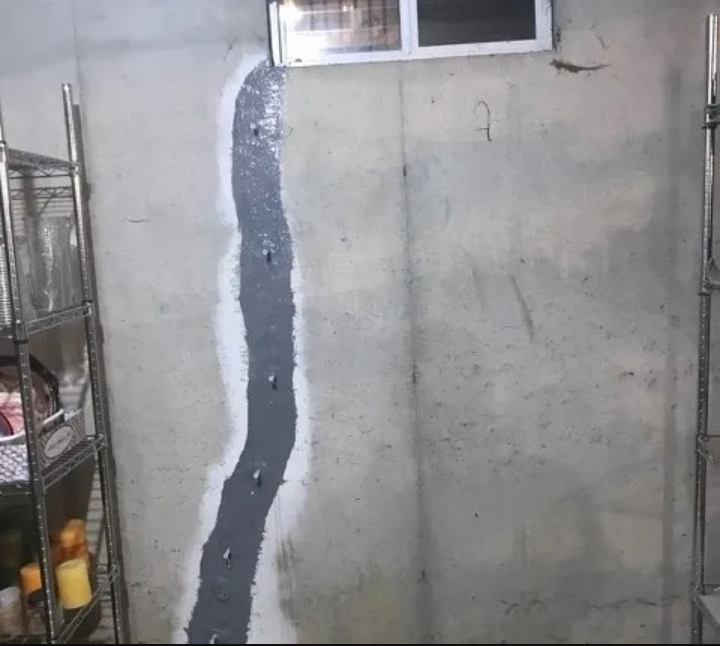
Each of these methods offers a tailored approach to specific foundation issues, and the decision involves factors like crack size, underlying soil conditions, and whether the damage is static or still progressing. For Portsmouth homeowners, addressing foundation cracks is as much about understanding the quirks of local geology as it is about applying the right technique. Opting for professional repair ensures your foundation will endure the unique challenges of coastal New Hampshire living.
Common Methods for Foundation Crack Repair in Portsmouth, NH
In Portsmouth, where the mix of coastal soil and fluctuating seasons puts homes through some tough tests, foundation crack repair is as much about addressing the problem as it is about preparing for what’s next. The following methods are among the most reliable solutions used by local professionals to tackle foundation issues effectively:
- Epoxy Injection: For cracks caused by settling but not associated with ongoing foundation movement, epoxy injection is a solid choice. This method involves injecting a durable, adhesive resin directly into the crack. Once cured, the epoxy bonds with the surrounding concrete, essentially “welding” the foundation back together. While it restores structural integrity, it’s not ideal for cracks that may still be shifting, so an assessment of movement is necessary before starting.
- Polyurethane Foam: When cracks let water seep through—common in Portsmouth’s soggy spring months—polyurethane foam is your answer. This solution works by injecting a liquid foam that expands to fill voids and seal cracks. The flexibility of the foam is particularly valuable when dealing with slight, ongoing shifts, as it can accommodate some movement without splitting open again.
- Steel or Carbon Fiber Straps: Horizontal cracks or bowing walls, both red flags for structural stress, may require reinforcement. Steel or carbon fiber straps are anchored against the foundation wall to prevent further movement. Carbon fiber is light and less invasive to install, while steel offers extreme durability. Either option provides an effective brace without needing to dig out and replace portions of the foundation.
- Excavation and Waterproofing: For major cracks accompanied by poor drainage, excavation and waterproofing are often necessary. First, contractors dig down to expose the damaged portion of the foundation. The crack is then repaired using hydraulic cement or similar materials, and waterproofing measures, such as exterior membranes or drainage panels, are installed. This approach not only fixes the existing issue but also reduces the likelihood of future water intrusion—a valuable option in Portsmouth’s water-prone environment.
- Helical or Push Piers:For homes affected by significant settlement or shifting soil—a more common issue near Portsmouth’s coastline—helical or push piers provide a long-term fix. These piers are driven deep into stable soil layers below the shifting surface soil. Once in place, they lift and stabilize the foundation, preventing further settling and ensuring long-term support. While expensive, this solution is often a lifesaver for homes on compromised ground.
Preventing Future Foundation Cracks
While you can’t overpower nature, you can outsmart it. Taking proactive steps today can save you from headaches (and steep repair bills) tomorrow. Foundations are finicky beasts, particularly in Portsmouth, NH, where seasonal shifts can wreak havoc. Here’s how to give your foundation a fighting chance.
- Improve Drainage: Water is your foundation’s worst enemy. Make sure gutters and downspouts are doing their job: directing rainwater at least five feet away from your home. If water tends to pool around your foundation despite this, consider adding a perimeter French drain—a simple but effective solution to keep moisture at bay.
- Control Landscaping: That towering oak tree shading the yard? It might be sneaking water away from your soil while its roots creep toward your foundation. Keep trees and shrubs with aggressive root systems at least 15-20 feet from your home. Choose foundation-friendly plants or consult a landscaper for guidance.
- Seal Exterior Cracks: See it, seal it. Any small gap or crack in your exterior foundation is an open invitation for water to crawl inside—or worse, freeze and expand during Portsmouth’s harsh winters. Use a quality weatherproof sealant and keep a watchful eye for new blemishes.
- Monitor Moisture Levels: Soil loves balance, just like most things in life. Excessive dryness can make it shrink away, while too much water turns it to mush, leading to shifting. During long dry spells, lightly watering the soil around your house can help maintain an equilibrium. Similarly, ensure heavy rains don’t over-saturate the ground near the foundation.
- Inspect Regularly: Seasonal changes are the foundation’s battleground. Make it a habit to walk around your home at least twice a year—spring and fall are good benchmarks—and check for new cracks, gaps, or signs of sinking. Think of it as giving your house its own wellness check-up.
A little foresight goes a long way. Stick to these basics and you’ll have a strong foundation (literally) to keep your Portsmouth home safe, stable, and standing tall.
The Importance of Addressing Foundation Cracks Quickly
When it comes to foundation cracks, procrastination can cost you. What starts as a seemingly harmless hairline crack can quietly evolve into a big, expensive headache. Small cracks may look cosmetic at first, but they’re often early warning signs of deeper issues, such as shifting soil, water pressure, or structural instability. The longer you wait, the more extensive—and costly—the repairs become.
Water intrusion is one of the fastest ways a minor crack morphs into a major problem. Once water finds its way in, it can saturate your basement or crawl space, leading to mold, mildew, and the musty smell you never want clinging to your home. Added moisture can also compromise air quality and even pose health risks. Left unchecked, these conditions often require both foundation repair and additional mitigation for water damage—a double hit to your wallet.
Ignoring cracks doesn’t only hurt your home’s condition; it can also dent your heating and cooling budget. Gaps in your foundation can let cold drafts seep in during New Hampshire’s brisk winters, forcing your HVAC system to work overtime. Over the long haul, this inefficiency spikes your energy bills while offering no return on investment.
But the real danger? Structural instability. Foundation cracks, particularly horizontal or diagonal ones, can signal significant stress within your home’s foundation. These are red flags that should never be ignored. If left unaddressed, they can lead to uneven floors, misaligned doors and windows, or even serious safety concerns like partial foundation failure. At that point, you’re not just looking at a repair—you’re staring down a reconstruction project.
The bottom line is harsh but simple: time is your enemy when it comes to foundation cracks. Addressing issues early can mean the difference between a straightforward epoxy injection and an invasive, multi-phase repair process. Be vigilant. Take a walk around your home, inspect your foundation, and act the moment you spot something amiss. Early intervention isn’t just practical—it’s peace of mind.
Selecting the Right Professional in Portsmouth, NH
Choosing the right contractor for foundation crack repair isn’t just a recommendation; it’s a vital step toward solving the problem correctly the first time. Here’s the bottom line: not all professionals are created equal, and cutting corners when selecting one could leave you with lingering issues. To make an informed choice, follow these straightforward but critical steps:
- Go Local: Contractors with experience in Portsmouth’s unique conditions—moist coastal soils, extreme freeze-thaw cycles—have a significant advantage. They’ll know what works and what doesn’t in this area’s climate.
- Credentials Matter: Always verify licensing and insurance. These aren’t just formalities; they protect you from liability and ensure the contractor meets professional standards. Inquire about industry certifications, too—they often indicate specialized training.
- Experience vs. Talk: It’s one thing to say you’ve handled foundation repairs; it’s another to have tangible results. Ask specifically about their experience with the type of repair you need, whether that’s epoxy injection or underpinning.
- Listen to Others: Check out online reviews—but read critically. A glowing five-star review with no details? Questionable. Reviews that mention a similar repair to yours? Much better. Request references and follow up with a quick call.
- Transparency is Key: A legitimate contractor will provide a detailed, written quote. If someone can’t explain the scope of the work, materials involved, or timeline without dancing around the details, it’s a red flag. Steer clear.

The takeaway here is simple: don’t rush the contractor selection process. A reputable professional will not only fix the crack but also identify and address the root cause, ensuring you won’t have to repeat the process down the line.
Final Thoughts
Foundation cracks are more than just cosmetic annoyances—they are warnings. In Portsmouth, NH, where the environment routinely tests the resilience of your home’s foundation, staying ahead of these issues is non-negotiable. The freeze-thaw cycles, shifting soils, and heavy rains of the region create perfect conditions for cracks to form and worsen if neglected. Treat them early, and you might only need a quick DIY fix. Ignore them, and you could end up with a costly structural problem that disrupts your life.
Procrastination is expensive when it comes to foundation health. Regular inspections, basic preventive measures like improving drainage, and swift action—whether by rolling up your sleeves or calling in pros—are your best defenses. Remember, foundations aren’t just slabs of concrete; they’re the backbone of your home. A solid, crack-free foundation means peace of mind, lower repair costs down the road, and, most importantly, the security of knowing your home is built to last. The bottom line? Don’t let small issues today turn into big regrets tomorrow. Stay vigilant. Stay proactive.
Reviews from Happy Customers
Our top priority is customer satisfaction, and we work closely with clients to understand their unique needs and goals.




